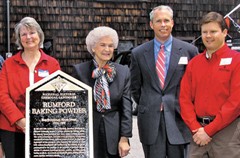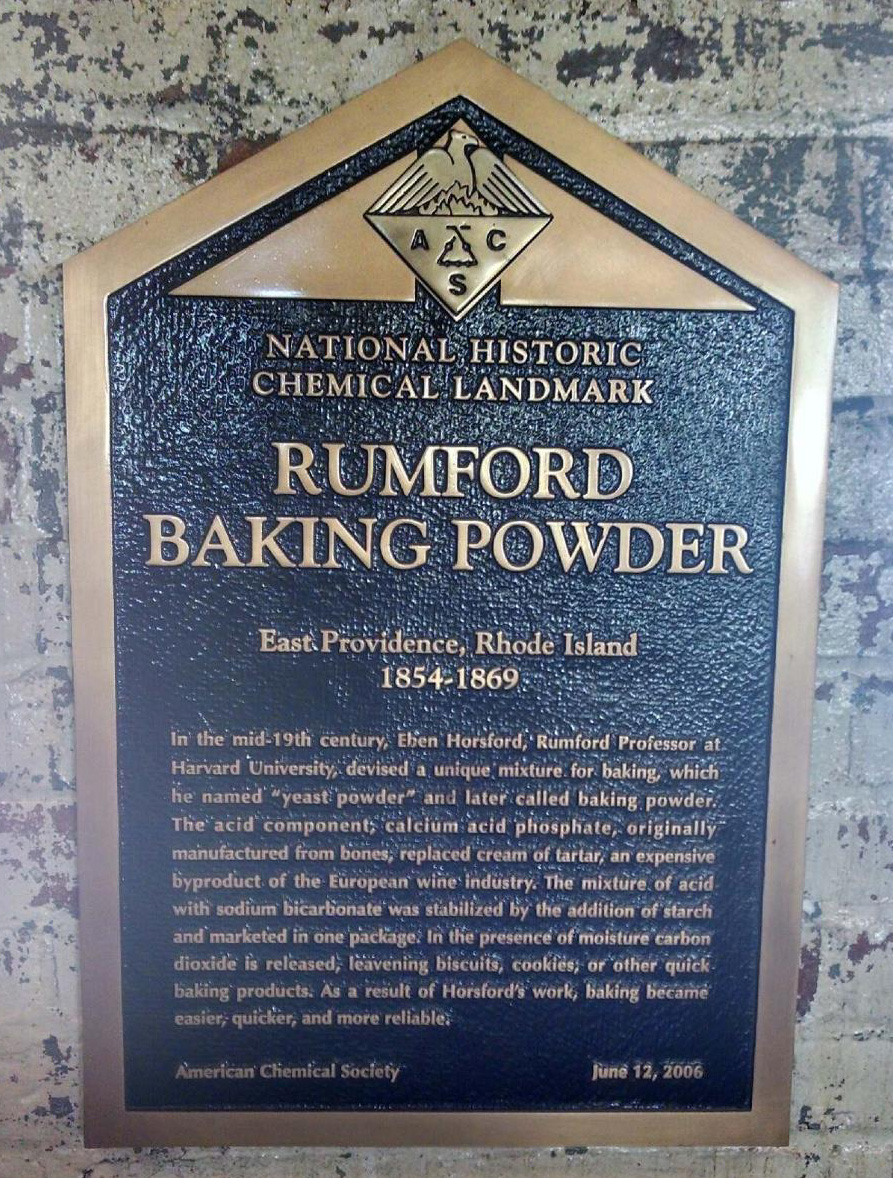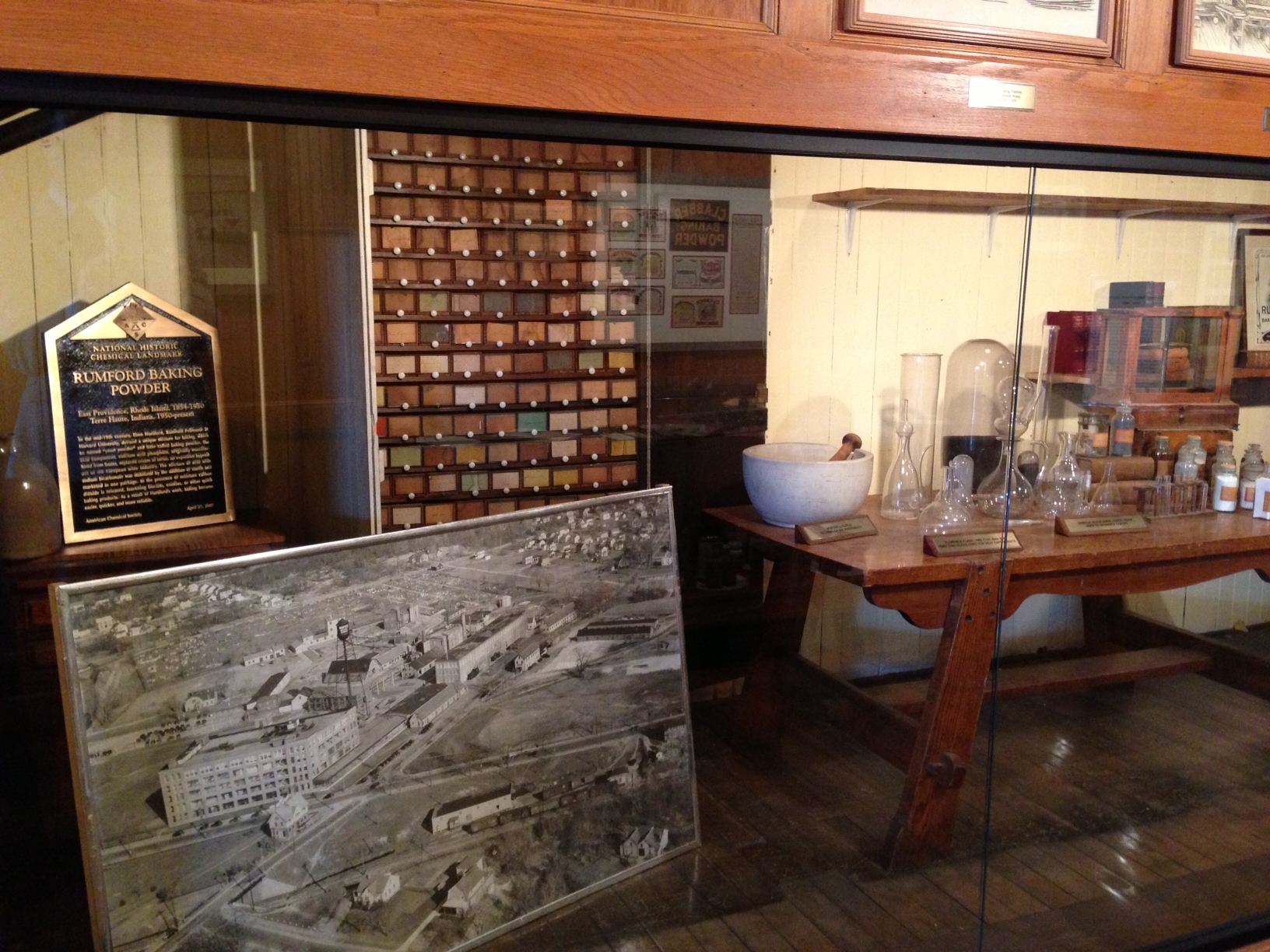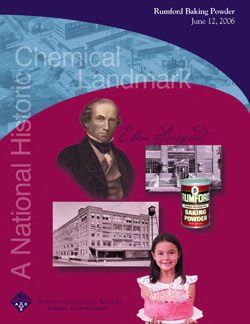Development of Baking Powder
Dedicated June 12, 2006, at the Rumford Chemical Works in East Providence, Rhode Island, and April 27, 2007, at Clabber Girl headquarters in Terre Haute, Indiana.
Bread is considered a basic foodstuff; eaten down through the ages, it continues to be a staple of the modern diet. The development of baking powder made baking easier, quicker and more reliable for bakers in the mid-19th century. Eben Horsford’s unique formula was an important innovation and made the making of biscuits, cookies and other quick baking products simpler than before.
Contents
History of Bread
The cultivation of wheat predates recorded history. Anthropologists conjecture that hungry hunter/gatherers first used wheat as a stored food source. Grown in ancient Mesopotamia and Egypt, wheat was probably chewed at first. Later, industrious and inventive—or at least observant—people discovered that the grain could be pulverized and made into a paste. When set over a fire, the paste—with water added—hardened into flat bread that could be kept for several days. Then early humans observed that when yeast was accidentally added to the paste the mixture would leaven, or rise.1
The realization that food could be prepared in advance and then kept through the winter months contributed to the rise of civilization. The ability to store food to ward off hunger and starvation ultimately gave people time to develop other useful skills besides hunting, fishing, and herding. That knowledge set the stage for subsequent social, economic, and political developments: the rise of cities, the stratification of societies, and the evolution from bands of hunters to tribes to nations.2
As humans and society developed, so did bread making. Bakers learned that instead of waiting for leaven to accidentally enter their dough the process could be somewhat regularized if they saved a piece of dough from one batch to put in the next. This is the origin of sourdough, and it is still used today. In Egypt, around 3,000 years ago, someone isolated yeast and discovered how to introduce the culture directly into dough. At the same time, a new strain of wheat was developed which permitted refined white bread. This may be said to be the first truly modern bread.
The Greeks learned bread-making from the Egyptians; from Greece the practice spread over Europe. The Roman welfare state was based on the distribution of grain to Roman citizens. The government of Rome ran public bakeries for doling out bread to the poor. In 168 BCE a Bakers' Guild—the Collegium Pistorum—was formed in Rome, and it established rules and regulations for bread-making. The Collegium Pistorum did not allow bakers or their children to withdraw from the guild and enter other professions; but it did protect the special privileges the state granted bakers. Bakers were, for example, the only free people in the city of Rome; all other trades employed enslaved people.
Through much of history the color of bread revealed social status: The darker the bread, the lower a person's status. This was because white flours were more expensive and harder to adulterate with other products. But preferences change; today, darker breads are more expensive and prized for their taste and nutritional value.
Throughout the Middle Ages and well into the modern era the price and availability of bread was often linked to social stability. During much of European history, for example, there were recurring periods of famine which affected the availability of bread, a dietary staple. The ruling classes—aware that rebellion often followed famine—regulated prices to avoid the cost rising too high. Still, bread riots frequently rocked the stability of Europe, most notably in the events leading to the French Revolution.
Development of Baking Powder
For more than three millennia, the method of baking bread did not change substantially; that is, until the 1830s when bakers began adding sodium bicarbonate (bicarbonate of soda) and sour milk to their dough. The lactic acid in the sour milk reacted with the sodium bicarbonate to produce carbon dioxide, which, trapped in the dough, resulted in the desired lightness of the baked bread. The introduction of sodium bicarbonate with an acid marked a significant advance in baking technique. But its applicability was limited since baking powder works better in cakes and biscuits than in breads. As a result, most bread makers continued to use sour dough.3
Adding sour milk to dough or batter presented a problem: the chemical reaction depended upon the degree of acidity in the sour milk, which made the resulting rising unpredictable. In the 1840s the introduction of cream of tartar (potassium hydrogen tartrate), a byproduct of wine fermentation, solved this problem. Cream of tartar greatly improved and regularized the baking process since the uniformity of both sodium bicarbonate and cream of tartar offered bakers better control of the leavening process, allowing for predictable results.
The mixing of sodium bicarbonate and cream of tartar marked the introduction of baking powder. The action of the two chemicals—initially marketed in twin envelopes—began as soon as they were added to the wet dough or batter. Bakers began buying both chemicals in bulk, but they had to be kept separate to prevent a premature acid-base reaction occurring. This required extra time in measuring. And there was an additional problem as cream of tartar was imported from France and Italy. The supply and price of cream of tartar was erratic depending on the grape harvest. These two factors—that the components of baking powder had to be kept separate and that the availability of cream of tartar was erratic—fueled the search for a more efficient and economical baking powder.
It was at this point that a German-educated, Harvard chemist named Eben Horsford suggested replacing the cream of tartar with calcium acid phosphate, which he knew as monocalcium phosphate. Horsford then developed a process to manufacture calcium acid phosphate, for which he received a patent on April 26, 1856.4 Earlier, Horsford and his partner, George Wilson, had established the Rumford Chemical Works for the manufacture of chemicals; soon the plant was producing calcium acid phosphate. In the early years of the factory the source for calcium was bones, which were treated with sulfuric acid. This resulted in a mixture of phosphoric acid, superphosphates, and calcium sulfate, which was laboriously fractionated to yield calcium acid phosphate, which Horsford called "pulverulent (powdered) phosphoric acid."
The first packaged products from the Rumford Chemical Works were correctly proportioned supplies of calcium acid phosphate and sodium bicarbonate marketed as Horsford's Bread Preparation. While the introduction of calcium acid phosphate satisfied the supply problem presented by cream of tartar, the baker still had to mix two products to get a satisfactory leavening agent. Since it was the presence of water which began the reaction process, Horsford solved the problem by drying the ingredients sufficiently. To keep them dry, he added corn starch to the mixture as the vital third ingredient. Horsford had discovered that finely ground calcium acid phosphate and bicarbonate of soda could be mixed with finely divided corn starch to prevent a premature chemical reaction. Corn starch remains an essential feature of most baking powders.
The baking powder devised by Horsford first carried his name, only later becoming Rumford Baking Powder. As such it was marketed for decades and contained the same three ingredients—calcium acid phosphate, sodium bicarbonate, and corn starch—in the same proportions as in Horsford's day. The only significant change came in the source of the calcium acid phosphate; in the late 1880s, the introduction of calcium phosphate mining eliminated the need for beef bones.
Eben Horsford (1818-1893)
Eben Norton Horsford was born in Moscow (now Livonia), New York, on July 27, 1818. Livonia is near Rochester and the young Horsford witnessed the completion in 1825 of the Erie Canal which opened up markets for the wheat grown in the interior of New York State. But by the 1830s, progressive farmers like Horsford's father recognized that intensive agriculture had led to soil depletion.5
Horsford entered the Rensselaer School (now Rensselaer Polytechnic Institute) in 1837, graduating a year later with a B.S. in civil engineering. For the next few years he worked for the New York State Geological Survey and taught a yearly lecture course on chemistry at Newark College in Delaware. In the early 1840s Horsford taught mathematics and natural history at the Albany Female Academy, where he fell in love with a student, Mary L'Hommedieu Gardiner. Her father refused to approve the marriage until Horsford's prospects improved, so the two did not marry until August 1847.
Horsford's work as geologist led to membership in the American Association of Geologists and Naturalists (forerunner of the Association for the Advancement of Science) and contact with John Webster, Professor of Medicine at Harvard College. Webster edited the first edition of Justus von Liebig's Organic Chemistry and Its Application to Agriculture and Physiology (1841). Horsford—according to his diary—read Liebig's book in 1842; at the same time, Horsford's associates urged him to go to Giessen, Germany, to study with Liebig for what would be Horsford's only formal education in chemistry. This expensive education abroad was made possible by Horsford's Albany friends, who paid for part of the trip and agreed to lend him money to cover the rest.
It was not uncommon for young Americans to travel to Europe in the 19th century for advanced scientific training, especially at German universities. Horsford's wish to study with Liebig especially proved apt as the German chemist's approach to science was practical, believing it should serve the public good. Liebig considered himself an agricultural chemist, an emphasis that appealed to Americans living in what was a predominantly rural, agrarian society. Liebig had an international reputation, and through his writings and the students he trained, he exerted great influence over chemistry and agriculture in the United States.6
Horsford's first meeting with Liebig did not go well, with the American complaining that he was "received indifferently."7 But this changed early in Horsford's stay in Giessen, and soon the student was on intimate relations with the teacher and his family. No doubt this close connection eased Horsford's stay in Germany since Giessen was a small town of only about 8,000 people and the University of Giessen had only about 500 students, of whom 60 were studying chemistry. Liebig's presence on the faculty attracted students from around the world. Horsford wrote reverentially of attending his first lecture given by Liebig. The students rose when the professor entered the hall and "all was breathless." Horsford understood little German, but commented that Liebig's experiments were "executed with skill, dexterity, grace, and rapidity."8
Horsford spent two years in Giessen, studying the nutritive value—including the protein content—of various grains among other topics in organic chemistry. He did not stay long enough to receive a doctorate. Three reasons have been offered for his failure to obtain a degree: he did not want to incur more debts; his limited academic training prior to his sojourn in Germany; and he needed a job in order to marry. In any event, while in Germany, he was nominated for the Rumford chair at Harvard University. This academic post had been established by Count Rumford, an inventor and entrepreneur. With the strong support of Liebig and his old mentor Webster, Horsford was formally offered the professorship in February 1847, with an annual salary of $1,500.
The letter from Harvard's president, Edward Everett, offered Horsford a place in a soon-to-be established scientific school. Everett assured Horsford that his work was "not to be arduous," with his teaching responsibilities limited to two hours a day. "We shall endeavor," Everett wrote, "to give you as much time as possible for the pursuit of your investigations. You shall have a good laboratory, well furnished and a cordial welcome from all your associates."9 Later in 1847, the Rumford chair was transferred to the Lawrence Scientific School, created on a gift from Abbott Lawrence, and Horsford's salary doubled to $3,000 a year.
Now established as a professor, Horsford married Mary Gardiner on August 4, 1847. She died in 1856, leaving four daughters. In 1858, he married his sister-in-law Phoebe Gardiner; they had one daughter. During these years Horsford's career at Harvard progressed: He developed a laboratory for chemical analysis modeled on Liebig's facility in Giessen; and he became dean of the Lawrence Scientific School. He continued to correspond with Liebig; indeed, his research displayed the same interest in practical chemistry learned in Germany. For example, he studied the Boston water supply with emphasis on the effect of water on lead and iron pipes. He analyzed a sample of guano for William Marcy, the Secretary of State.
He continued his interest in the chemistry of nutrition, with early studies on potatoes and the condensation of milk. After 1854, his main preoccupation was to discover a substitute for yeast in baking bread.10 At the same time, Horsford entered into a business partnership with George Wilson, a former textile manufacturer, to establish the Rumford Chemical Works. As the business prospered, Horsford became less interested in teaching and university administration, and, in 1861, he resigned as dean of the Lawrence Scientific School. Two years later, he retired from the Rumford chair.
In 1861, Horsford published The Theory and Art of Breadmaking.11 During the Civil War he offered advice to the military, and he developed a "marching ration" composed of condensed meat and grain, which was ultimately unsuccessful.12 After the Civil War, he largely abandoned science in favor of a number of avocations, including trying to prove that the Vikings established a settlement near Boston. He could indulge his hobbies since he prospered from the chemical works he established with Wilson. As the father of five girls, Horsford spent part of his wealth on supplying Wellesley College with books and apparatus. During these years he continued to live in Cambridge, Massachusetts, until his death on January 1, 1893.
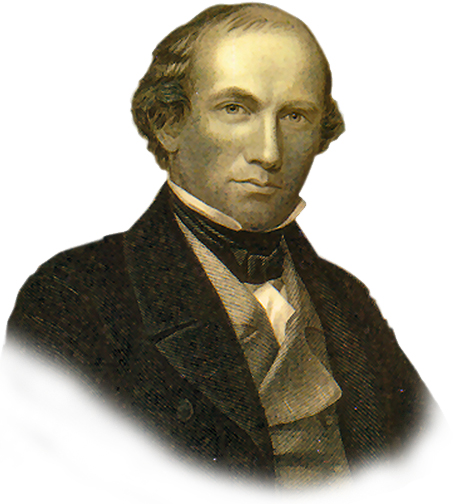
Rumford Chemical Works
Professor Eben Horsford and George Wilson joined forces to establish a plant to manufacture chemicals needed by New England's many and varied industries. Horsford was Rumford Professor at Harvard University and Wilson was a school teacher with a flair for industry who wished to enter business. Early in 1854 Wilson left his principal's post at Chicago Academy and returned to his native Uxbridge, Massachusetts, with the aim of starting a business. He established a chemical merchandising firm in Providence, Rhode Island, which he named George F. Wilson & Co. and which specialized in the supply of chemicals to the local textile industry. Later that year, Wilson sought Horsford's cooperation in the development of chemical products which Wilson would manufacture.13
Horsford eagerly seized upon Wilson's offer as he had just received his first patent for a chemical process, the use of calcium sulfite to neutralize chlorine in bleached cotton and linen fabrics. Since Wilson was interested in textile chemicals, the two men built a small calcium sulfite plant in Pleasant Valley, Rhode Island. Unfortunately, the site they picked proved unacceptable as neighbors complained about the constant escape of sulfur dioxide during the manufacturing process. In 1856 Wilson moved the equipment in the Pleasant Valley plant to a facility on a site in East Seekonk, Massachusetts, which he had purchased.
Horsford had linked up with Wilson in part because he wanted an outlet for the manufacture of calcium sulfite. At the same time, he was working on other ideas that might yield products for marketing. One of those ideas was an alternative to yeast or sour milk as a leavening agent, which would eventually be baking powder. In 1856 Horsford received a patent for "pulverulent phosphoric acid," which coincided with the transfer of operations from Pleasant Valley to East Seekonk.
Although chemists were familiar with phosphoric acid in the 1850s, it had not been produced on a commercial scale. So Horsford and Wilson needed to develop a manufacturing process based on then available raw materials, either bones or spent bone char from sugar refining. Geologists were aware of U.S. phosphate deposits, but they were not exploited until 1869. But by the beginning of the Civil War, Horsford and Wilson had solved the supply problem and were producing enough calcium acid phosphate to satisfy production needs for baking powder.
Prosperity meant that the informal partnership between Horsford and Wilson needed to be converted into a corporate structure; as such, the Rumford Chemical Works was incorporated under Massachusetts law in 1859 with capital of $10,000. Horsford chose the corporate name which recognized the scientific achievements of Benjamin Thompson, Count Rumford, as well as the Rumford Chair which he occupied at Harvard and which had been founded by a grant from Count Rumford. In 1861 the boundary between Massachusetts and Rhode Island was adjusted with the result that East Seekonk Massachusetts, became part of East Providence, Rhode Island, so the corporation had to be chartered again in Rhode Island.
In addition to marketing Horsford's pulverulent phosphoric acid, the firm was producing hydrochloric and nitric acids and tin chloride. In 1864 Horsford obtained a patent for a self-rising flour containing calcium acid phosphate and sodium bicarbonate. While Horsford was developing processes, Wilson invented equipment for the implementation of Horsford's discoveries. For example, in 1868 Wilson received patents for a phosphoric acid pump with vulcanized rubber valves and for the use of porcelain-lined iron kettles for concentrating phosphoric acid. Wilson also devised methods for using bone and spent bone char in the manufacture of agricultural fertilizers.
Baking powder was the main output of the Rumford Chemical Works. By the mid-1860's "Horsford's Yeast Powder" was on the market as an already mixed leavening agent, distinct from separate packages of calcium acid phosphate and sodium bicarbonate. This was packaged in bottles, but Horsford was interested in using metal cans for packing; this meant the mixture had to be more moisture resistant. This was accomplished by the addition of corn starch, and in 1869 Rumford began the manufacture of what can truly be considered baking powder.
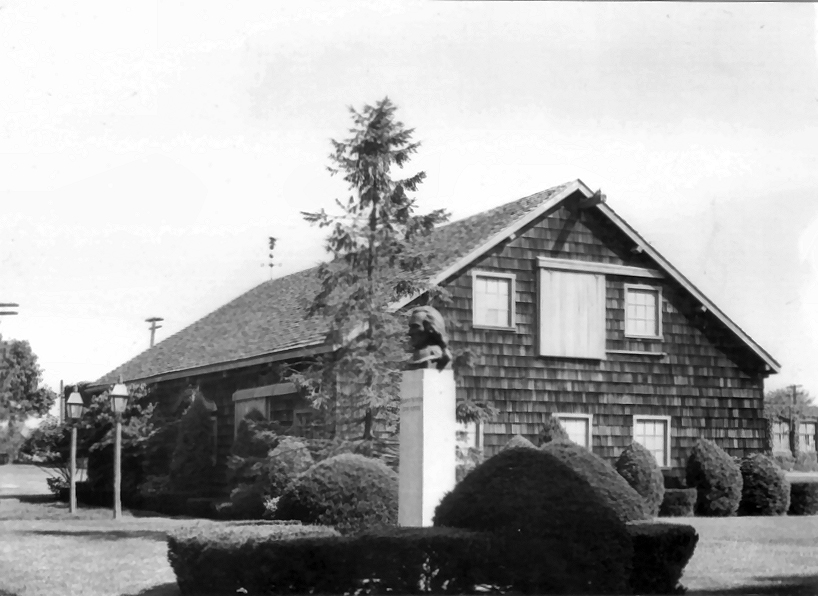
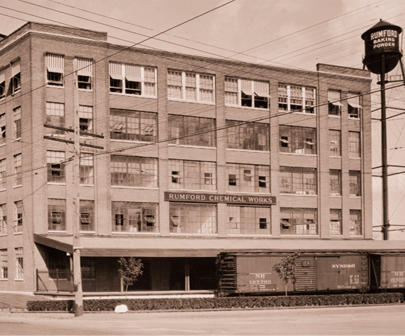
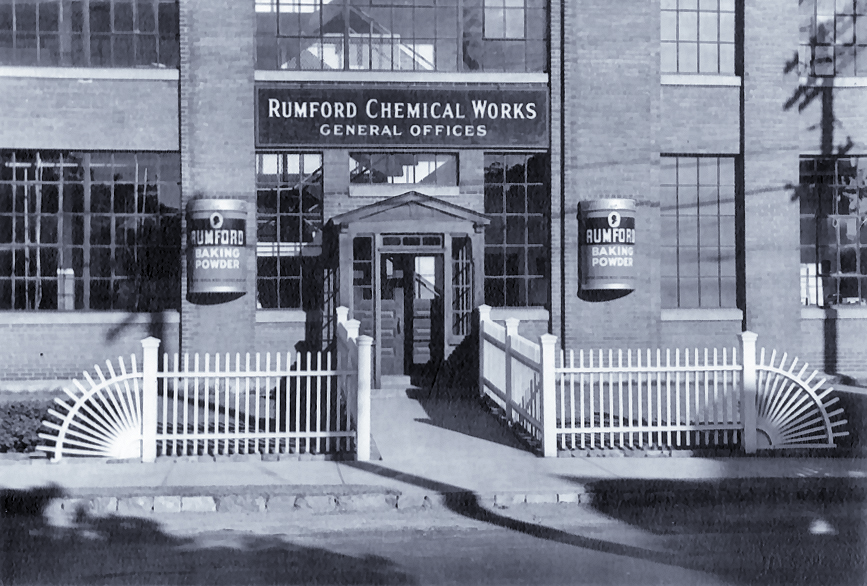
Count Rumford (Benjamin Thompson), 1753-1814
Benjamin Thompson—better known to history as Count Rumford—was one of the two preeminent scientists, along with Benjamin Franklin, born in 18th-century America. Thompson was born in Woburn, Massachusetts, on March 26, 1753. As a thirteen-year-old, Thompson was apprenticed to a Salem merchant for three years. After that, he served as an apprentice clerk in Boston, enrolled as a medical student, and taught school. He also occasionally attended lectures at Harvard University on physical science.14 In 1772, when he was 19, Thompson was summoned by the Reverend Timothy Walker to teach in Concord, New Hampshire, which earlier had been known as Rumford.15
Within a few months of arriving in Concord, Thompson married the Reverend's daughter, Sarah Walker Rolfe, whose deceased first husband left her a large estate. Through his wife, Thompson met the colonial governor, John Wentworth, who commissioned him in the New Hampshire militia. This appointment apparently caused resentment among his neighbors who felt there were veterans of the so-called French and Indian War better qualified for the commission. Also, Thompson did not participate in the growing fervor in the 1770s against British rule. His unpopularity in Concord forced him to leave his wife and infant daughter to return to Massachusetts.
In May 1775 Thompson was arrested on the charge of "being inimical to the liberties of this country." He was released but never received a public hearing. He also may have been the author of a secret letter to British General Gage which conveyed military information about colonial troops during the siege of Boston. In late 1775 Thompson sent General Howe, Gage's successor, a lengthy report on the numbers, disposition, and equipment of American forces surrounding Boston. When Howe evacuated Boston in March 1776, Thompson sailed to England.
Thompson entered the British Colonial Office, becoming an advisor to the Secretary of State for North America, Lord George Germain, at whose estate in 1778 he performed a series of experiments in the interior ballistics of small arms. In 1779 he was made a fellow of the Royal Society. He also continued his ballistic experiments, switching to studying cannons in the Royal Navy. He contributed an original design for an armed frigate to a treatise on naval architecture published in 1781.
In 1780 Thompson became Secretary of State for the Northern Department, which comprised New York, New England, and sections of Canada. The following year he received a commission in the British Army as a lieutenant colonel and left for America, shortly before Germain was drummed out of the colonial service by critics who accused him of incompetence in prosecuting the war with the rebellious colonies. He returned to England in 1783, but soon left for travel on the continent. It appears that Thompson envisioned a brighter future outside England since the influence of his friends and patrons had waned.
After several months wandering Europe, Thompson entered the service of the Elector of Bavaria, in whose employ he remained for fifteen years, achieving prominence as a public servant. He cleaned the streets of Munich of beggars, giving them clean quarters and putting them to work. He reformed the organization of the military, which raised morale, lessened the paperwork required of officers, and improved the pay, provisions, and leisure time of enlisted men. He planned and developed the English Garden, which still exists. At the age of 36 the King of England knighted Thompson; at 38 the Elector made him a Count of the Holy Roman Empire. Thompson was allowed to choose his own title; he selected Count Rumford, after the name by which Concord, New Hampshire, had been known before 1765.
In the early 19th century Rumford raised money for the Royal Institution of Great Britain, founded in 1800 for "teaching the application of scientific discoveries to the improvement of arts and manufactures in this country and to the increase of domestic comfort and convenience." The Institution consisted of a museum to exhibit useful machines, a scientific library, and a research laboratory. Rumford played a major role in the early success of the Institution, which was founded at a time when there were no institutional laboratories, and scientists conducted experiments in their homes. The first educational establishment to provide laboratories for students was Rensselaer Polytechnic Institute, founded in 1824 in the United States. It was not until the 1870s that the famous Cavendish Laboratory opened in Cambridge, England.
No doubt, Rumford's interest in public facilities for scientific research stemmed from his own scientific inquiries. In addition to his interest in gunpowder, Rumford did research on light, some chemical studies, and wrote at least one paper on mechanics. His inventions include a photometer and a calorimeter, and, given his interest in the "useful arts," he devised a stove, a roaster, and a lamp with multiple wicks. But his major scientific focus was on heat and his most important discoveries centered on the contention that heat is a form of motion.
Rumford spent the last dozen years of his life in Paris. In 1805—his first wife having died in 1792—he married the widow of the famous French chemist, Antoine Lavoisier. It was not a happy marriage; the couple separated in 1809, and Rumford moved to Auteuil, where he died in 1814. In his will he left Harvard University an annuity of $1,000, plus some additional funds, to establish a professorship "to teach… the utility of the physical and mathematical sciences for the improvement of the useful arts, and for the extension of industry, prosperity, happiness, and well-being of Society." The professorship was created in 1816 and the third Rumford Professor was Eben Horsford.
Research Notes and Further Reading
Research Notes
- This discussion is informed by the following: Bernard Dupaigne, The History of Bread, trans. Antonio and Sylvie Roder, (New York: Abrams, 1999) and the following Web sites: "The Story Behind a Loaf of Bread: The History of Bread.
- For a riveting account of the rise, and fall, of civilizations, see Jared Diamond, Guns, Germs, and Steel, (New York: W.W. Norton, 1997).
- For the history of baking powder, see the following: Anon., Eighty Years of Baking Powder History: 1859-1939, Rumford, RI, Rumford Chemical Works, 1939; Eben Norton Horsford, The Theory and Art of Bread-Making: A New Process Without the Use of Ferment (Cambridge, Mass: Welsh Bigelow & Co., 1861); Paul R. Jones, "Justus Von Leibig, Eben Horsford and the Development of the Baking Powder Industry," Ambix 40, Part 2 (1993): 65-74; Anon, "History of the Rumford Chemical Works," typed manuscript, dated April 15, 1947, in the East Providence Historical Society; Anon., "The Story of Baking Powder — The Story of Rumford, reprint from Oil-Power in East Providence Historical Society.
- See the application for a patent in the East Providence Historical Society.
- On Horsford's life, see Samuel Rezneck, "The European Education of an American Chemist, and Its Influence in 19th-Century America: Eben Norton Horsford," Technology and Culture 11 (1970): 366-88.
- On Horsford in Giessen, see Margaret W. Rossiter, The Emergence of Agricultural Science; Liebig and the Americans, 1840-1880, New Haven, CT: Yale University Press, 1975); H.S. van Klooster, "Liebig and His American Pupils," Journal of Chemical Education, 33 (1956): 494-97; Paul R. Jones, "Justus von Leibig, Eben Horsford and the Development of the Baking Powder Industry," Ambix 40, Part 2 (1993): 65-74.
- Rezneck, "European Education of an American Chemist," p. 370.
- Ibid, p. 371.
- Ibid, p. 381.
- Liebig was also interested in baking powder, and there has been some dispute in the literature over who did what first. Paul Jones has established that Horsford deserves recognition for inventing baking powder, a view shared by Liebig himself. See Jones, "Justus von Liebig , Eben Horsford and the Development of the Baking Powder Industry," p. 73
- Eben Norton Horsford, The Theory and Art of Bread-Making: A New Process Without the Use of Ferment (Cambridge, Mass: Welsh Bigelow & Co., 1861).
- Samuel Rezneck, "Horsford's 'Marching Ration" for the Civil War Army," Military Affairs 33 (1969): 249-255.
- Anon., Eighty Years of Baking Powder History: 1859-1939, Rumford, RI, Rumford Chemical Works, 1939; Anon, "History of the Rumford Chemical Works," typed manuscript, dated April 15, 1947, in the East Providence Historical Society; Anon., "The Story of Baking Powder — The Story of Rumford, reprint from Oil-Power in East Providence Historical Society.
- In Thompson's day physical science would have been called natural philosophy.
- On the colorful and controversial life of Benjamin Thompson, see the following: Sanborn C, Brown, Benjamin Thompson, Count Rumford, (Cambridge, Mass: MIT Press, 1981); C. Raymond Adams, "Benjamin Thompson, Count Rumford," The Scientific Monthly 71, No. 6 (December 1950): 380-86.
Further Reading
- The Rumford Center History (Rumford Center, East Providence, Rhode Island)
- Rumford, East Providence, RI, Walking Tour (National Park Service Blackstone River Valley National Heritage Corridor)
- Clabber Girl Heritage (Clabber Girl Corporation, Terre Haute, Indiana)
- Clabber Girl Museum (Clabber Girl Corporation, Terre Haute, Indiana)
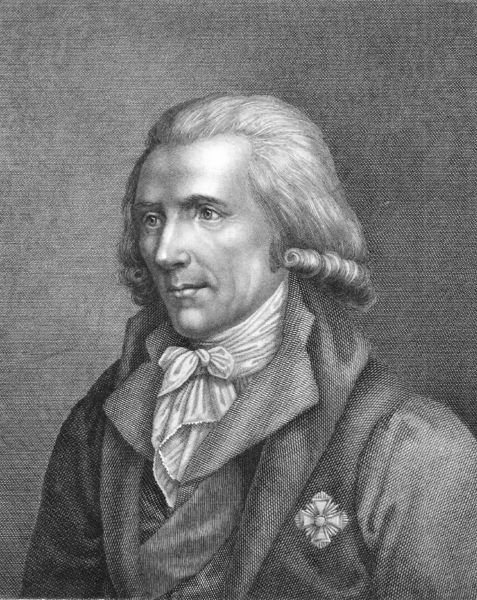
Landmark Dedication and Acknowledgments
Landmark Dedication
The American Chemical Society dedicated the development of baking powder by Eben Horsford a National Historic Chemical Landmark in a ceremony at the Rumford Chemical Works in East Providence, Rhode Island, on June 12, 2006, and at Clabber Girl headquarters in Terre Haute, Indiana, on April 27, 2007. The commemorative plaques read:
In the mid-19th century, Eben Horsford, Rumford Professor at Harvard University, devised a unique mixture for baking, which he named "yeast powder" and later called baking powder. The acid component, calcium acid phosphate, originally manufactured from bones, replaced cream of tartar, an expensive byproduct of the European wine industry. The mixture of acid with sodium bicarbonate was stabilized by addition of starch and marketed in one package. In the presence of moisture carbon dioxide is released, leavening biscuits, cookies, or other quick baking products. As a result of Horsford's work, baking became easier, quicker, and more reliable.
Acknowledgments
Adapted for the internet from “Rumford Baking Powder,” produced by the National Historic Chemical Landmarks program of the American Chemical Society in 2006.
Back to National Historic Chemical Landmarks Main Page.
Learn more: About the Landmarks Program.
Take action: Nominate a Landmark and Contact the NHCL Coordinator.
En español: El desarrollo de la levadura química
